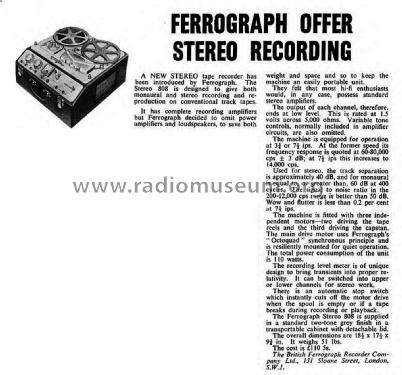- Country
- Great Britain (UK)
- Manufacturer / Brand
- Ferrograph, British Ferrograph Recorder (Wright & Weaire); London
- Year
- 1959 ?
- Category
- Sound/Video Recorder and/or Player
- Radiomuseum.org ID
- 343010
- Main principle
- Audio-Amplification
- Wave bands
- - without
- Details
- Tape Recorder
- Power type and voltage
- Alternating Current supply (AC) / 103-117/205-245 Volt
- Loudspeaker
- Permanent Magnet Dynamic (PDyn) Loudspeaker (moving coil)
- Material
- Leather / canvas / plastic - over other material
- from Radiomuseum.org
- Model: Stereo 808 - Ferrograph, British Ferrograph
- Shape
- Tablemodel, Box - most often with Lid (NOT slant panel).
- Dimensions (WHD)
- 470 x 248 x 444.5 mm / 18.5 x 9.8 x 17.5 inch
- Notes
-
Ferrograph Stereo 808
A NEW STEREO tape recorder has been introduced by Ferrograph. The Stereo 808 is designed to give both monaural and stereo recording and reproduction on conventional track tapes.
It has complete recording amplifiers but Ferrograph decided to omit power amplifiers and loudspeakers, to save both weight and space and so to keep the machine an easily portable unit.
They felt that most hi-fi enthusiasts would, in any case, possess standard stereo amplifiers.
The output of each channel, therefore, ends at a low level. This is rated at 1.5 volts across 5,000 ohms. Variable tone controls, normally included in amplifier circuits, are also omitted.
The machine is equipped for operation at 3¾ or 7½ ips. At the former speed, its frequency response is quoted at 60-8,000 cps + 3 dB; at 7½ ips this increases to 14,000 cps.
Used for stereo, the track separation is approximately 40 dB, and for monaural is equal to, or greater than, 60 dB at 400 cycles. The signal-to-noise ratio in the 200-12,000 cps range is better than 50 dB. Wow and flutter is less than 0.2 % at 7½ ips.
The machine is fitted with three independent motors – two driving the tape reels and the third driving the capstan. The main drive motor uses Ferrograph’s “Octoquad” synchronous principle and is resiliently mounted for quiet operation. The total power consumption of the unit is 110 watts.
The recording level meter is of unique design to bring transients into proper relativity. It can be switched into upper or lower channels for stereo work.
There is an automatic stop switch that instantly cuts off the motor drive when the spool is empty or if a tape breaks during recording or playback. Press Release, Tape Recording & Hi-Fi Magazine December 1959.
Specifications:
- Recording sense: Twin-track–either simultaneous or upper track only.
- Track width: 0.085 in
- Playing time (standard tape) : MONO – 1½ and 3 hours at 3¾ ips.
- STEREO 45 minutes at 7½ ips; and 1½ hours at 3¾ ips.
- Frequency response: 60-8,000 cps ±3dB at 3¾ ips. 60-14,000 cps ±3 dB at 7½ ips.
- Wow and flutter: Less than 0.2 % at 7½ ips
- Input levels: 1 – 3.0 mV rms (min.) 2 – 300.0 mV rms (min.)
- Input impedances: 1 and 2: 0.5 Megohms (approx.).
- Output levels: 1 and 2. 1.5 V (min.) into 5,000 ohms or greater (cathode follower).
- Signal-to-noise ratio : Better than 50dB from 200 to 15,000 cps (45dB min. overall)
- Track separation (stereo) : 40 dB (approx.)
- Lower track rejection (Mono): 60dB minimum at 400 cps.
The Ferrograph Stereo 808 is supplied in a standard two-tone grey finish in a transportable cabinet with a detachable lid.
- Net weight (2.2 lb = 1 kg)
- 51 lb (51 lb 0 oz) / 23.154 kg
- Price in first year of sale
- 105.00 GBP
- Mentioned in
- -- Original prospect or advert (Hi-Fi News January 1960 Vol. 4 No. 8)
- Literature/Schematics (1)
- -- Original prospect or advert (Tape Recording UK Dec 1959, Page 114)
- Author
- Model page created by Franz Scharner. See "Data change" for further contributors.
- Other Models
-
Here you find 21 models, 18 with images and 8 with schematics for wireless sets etc. In French: TSF for Télégraphie sans fil.
All listed radios etc. from Ferrograph, British Ferrograph Recorder (Wright & Weaire); London

